This lovely cardinal really brightens up the wintry landscape! It is also easy enough for anyone to paint. If you are looking for a gift idea or would like to add this painting to your holiday decor, come and join us!
We will be creating this 12" x 16" painting on Saturday, December 12. Suitable for ages 10 and up. Book your seat for just $20 (normally $25). Please contact the Art Center if you plan to attend.
Just click the Contact Us tab on our website (you can also pay through PayPal too; just click on the Painting Events tab).
Or call us at 252-7126 to check on seating availability. This painting is also available for a private painting party. Call to book your party!
An online journal of the Blackfoot Art Center, located in the small Southeastern Idaho community of Blackfoot. Our goals are to inspire artistic exploration, encourage creative growth, and foster curiosity and excitement about the visual arts.
Wednesday, December 09, 2015
Saturday, November 07, 2015
Mixed Media Project - Super Fun!
We created these AMAZING abstract pieces using two basic types of media, and one more thing: playfulness!
PART 1: We tore colors, pictures, and text out of magazines, newspapers, and art paper scraps, and arranged them rather randomly on a piece of white construction paper (rule: no scissors allowed). Then we glued them down. The artwork on the right, created by 12-year-old Isaac, included folded paper bits protruding from the background for a very interesting 3-D effect.
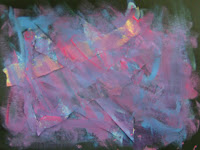 Part 2: Each artist selected two or three colors of tempera paint, plus white. They then mixed a few tints and hues of their own and added paint to collage. Each artist had his or her own style, and it was so much fun to watch! Paint was dabbed, blotted, swished, splattered, swirled, and splotched! The artwork itself was often used as a mixing palette, with delightful results; don't you agree?
Part 2: Each artist selected two or three colors of tempera paint, plus white. They then mixed a few tints and hues of their own and added paint to collage. Each artist had his or her own style, and it was so much fun to watch! Paint was dabbed, blotted, swished, splattered, swirled, and splotched! The artwork itself was often used as a mixing palette, with delightful results; don't you agree?
We decided we really like abstract art because it's fun to do and fun to look at!
PART 1: We tore colors, pictures, and text out of magazines, newspapers, and art paper scraps, and arranged them rather randomly on a piece of white construction paper (rule: no scissors allowed). Then we glued them down. The artwork on the right, created by 12-year-old Isaac, included folded paper bits protruding from the background for a very interesting 3-D effect.
 Part 2: Each artist selected two or three colors of tempera paint, plus white. They then mixed a few tints and hues of their own and added paint to collage. Each artist had his or her own style, and it was so much fun to watch! Paint was dabbed, blotted, swished, splattered, swirled, and splotched! The artwork itself was often used as a mixing palette, with delightful results; don't you agree?
Part 2: Each artist selected two or three colors of tempera paint, plus white. They then mixed a few tints and hues of their own and added paint to collage. Each artist had his or her own style, and it was so much fun to watch! Paint was dabbed, blotted, swished, splattered, swirled, and splotched! The artwork itself was often used as a mixing palette, with delightful results; don't you agree?We decided we really like abstract art because it's fun to do and fun to look at!
Thursday, November 05, 2015
"Autumn Colors" Painting Event!
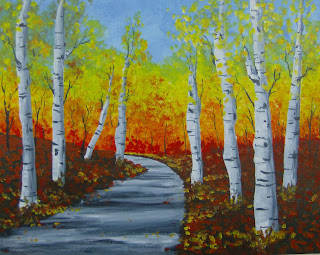 This guided painting event is scheduled for Saturday, November 14 at 1:00 to 3:30 pm. You will want to frame and display this lovely painting!
This guided painting event is scheduled for Saturday, November 14 at 1:00 to 3:30 pm. You will want to frame and display this lovely painting!This is a 16" x 20" stretched canvas, and suitable for painters 10 and up. No experience is necessary!
If you would like to join us, you can book your seat directly on our website or contact us via email, the contact us tab, or phone to let us know how many will be attending.
Saturday, October 31, 2015
Haunted Houses in Mixed Media
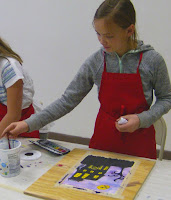 To do this project, you will need watercolor paper - 90 lb or 140 lb, a pencil, a set of watercolors, a medium round brush, soft tissues, black tempera paint, masking tape, a watercolor or drawing board, and a set of oil pastels.
To do this project, you will need watercolor paper - 90 lb or 140 lb, a pencil, a set of watercolors, a medium round brush, soft tissues, black tempera paint, masking tape, a watercolor or drawing board, and a set of oil pastels.Using masking tape, tape all four edges of the paper down to the board. (If using the lighter 90 lb paper, I suggest stretching it first by soaking briefly in water before taping it down to the board.)
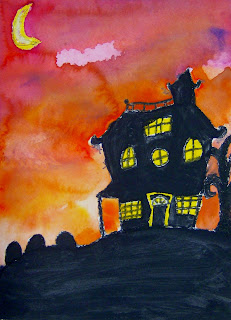 First, using your pencil, draw the spookiest haunted house you can think of. Start by drawing a small hill, and put the house on the hill. Add things like gables, banisters, towers, layered rooftops and lots of windows! You can also add a jack 'o lantern on the porch, gravestones, a dead tree, or a broken fence. Now, fill in the windows with a bright eerie yellow in oil pastel. Use this yellow or a lighter yellow or white to draw to fill in a large moon in the sky as well. Now, go over all of your pencil lines with black oil pastel, pressing firmly. You can fill in smaller, narrower shapes completely with the oil pastel. (Also draw in the window pane lines right over the yellow oil pastel.) You are creating a silhouette, so the blacker the better. Now, fill in the entire house shape with black tempera, leaving the windows unpainted, of course.
First, using your pencil, draw the spookiest haunted house you can think of. Start by drawing a small hill, and put the house on the hill. Add things like gables, banisters, towers, layered rooftops and lots of windows! You can also add a jack 'o lantern on the porch, gravestones, a dead tree, or a broken fence. Now, fill in the windows with a bright eerie yellow in oil pastel. Use this yellow or a lighter yellow or white to draw to fill in a large moon in the sky as well. Now, go over all of your pencil lines with black oil pastel, pressing firmly. You can fill in smaller, narrower shapes completely with the oil pastel. (Also draw in the window pane lines right over the yellow oil pastel.) You are creating a silhouette, so the blacker the better. Now, fill in the entire house shape with black tempera, leaving the windows unpainted, of course.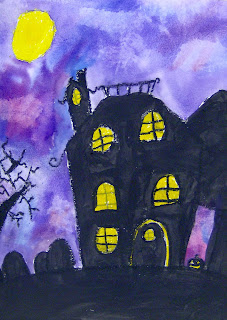
After allowing the tempera to dry, determine what colors to use in your sky. It is best to select two analogous colors, such as purple and blue, or red and orange, and put a few drops of water in those colors. Paint in the sky portion (not the moon) with clear water - don't miss any areas between fence posts or tree limbs! Now comes the fun part! Drop a few brush-fulls of color into your wet sky - this is called a wet-on-wet technique. Swirl the paint around just slightly if you want to, but don't make mud! Use the tissue to blot up paint here and there to create some spooky shapes. Add more paint as needed until you like the affect, then stop! Allow to dry, then carefully remove the tape by pulling outward (not upward - it will tear the paper) - slowly - away from the painting.
Hooty Owls in Oil Pastel
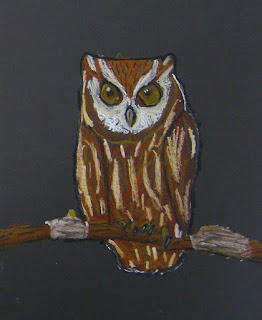 To create these amazing owls, you will need a set of oil pastels (24 or 36 is best), black construction paper (9 x 12), a pencil, a small easel, and a good color photo of an owl. We have files of resource pictures at the art center, including one of just owls. Most of our resource photos are collected from old calendars or nature magazines. Optional materials are masking tape, tracing paper and carbon paper.
To create these amazing owls, you will need a set of oil pastels (24 or 36 is best), black construction paper (9 x 12), a pencil, a small easel, and a good color photo of an owl. We have files of resource pictures at the art center, including one of just owls. Most of our resource photos are collected from old calendars or nature magazines. Optional materials are masking tape, tracing paper and carbon paper.First, select the photo of an owl you would like to use for your model. If the owl is large enough to trace and transfer to the art paper, I don't have any problem with that. Why? Because I consider this to be a lesson in oil pastel techniques, so I don't want the student to stress over or get hung up on the drawing part. We just want the image on the paper so we can begin play with the oil pastels!
Observing the owl model carefully (which should be displayed on the easel), the student draws it in pencil on the black paper, being carefully to center it and not make it too small. The owl (and a portion of whatever it is perched on) should fill the paper. If the student would rather transfer the owl image to the artwork, they will trace the basic shape of the owl on the tracing paper. They need to include only the major features such as the eyes, the beak, the talons, and any stark divisions in color (such as white areas to black areas). They should not try to draw every feather or detail. The image is then placed over the black paper with the carbon paper (shiny side up) sandwiched between. Use masking tape to tape down the "sandwich" at two or three corners so nothing moves around while transferring the image by drawing over the same pencil lines again. (You can lift a corner now and again to be sure the entire image has been traced.) Remove the carbon and tracing papers.
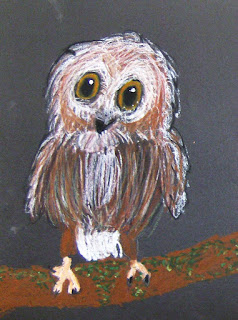 Now the student will create a palette for his or her owl art. One by one, select the oil pastels that might match the colors in your owl and hold them up to the photo. If you see that color anywhere in the photo, set it aside. This pastel stick becomes part of your palette. Continue until you have your complete palette, making sure you have included black and white. Keep these pastels separate until you have finished your art work.
Now the student will create a palette for his or her owl art. One by one, select the oil pastels that might match the colors in your owl and hold them up to the photo. If you see that color anywhere in the photo, set it aside. This pastel stick becomes part of your palette. Continue until you have your complete palette, making sure you have included black and white. Keep these pastels separate until you have finished your art work.We always begin with the eyes. Fill in the iris color (pressing firmly) and perhaps add a second similar color on top. Oil pastels mix beautifully when layered! Repeat with the other eye. Now add the pupils in black, and the black surrounding the eyes (look carefully at the photo to get the correct shape). When you are done, add a bright white spot somewhere in one eye (maybe upper right side of the pupil) then again in the other eye, same spot.
WOW! The eyes take on such an "alive" appearance, the rest of the owl seems easy. Just work your way out from the eyes, using strokes that imitate the growth of the feathers. In other words, don't stroke left to right if the feathers grow vertically. Use darker colors first, then highlight with lighter colors and white.
This project is a great introduction to serious oil pastel painting - we just love them! Oil pastels are especially suited to bird and animal portraits on black paper. Start with the eyes!
Monday, October 26, 2015
Halloween Themed Mini-Art Collages
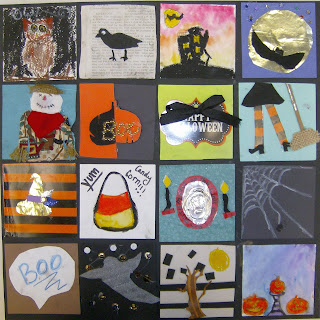
This was so much fun!
We made tiny pieces of Halloween art. Each piece was 4 x 4 inches, and was created independently of the others as a stand-alone work of art. We did oil pastel on black paper, fabric on paper, foil tooling with collage, watercolor with oil pastel, and lots of mixed media. Each person made 16 tiny works of art.
Then we arranged and rearranged our artwork on a large piece of poster board for mounting.The place was a mess, but the resulting artwork was worth it! (And clean-up wasn't that bad.)
Monday, September 14, 2015
Paint a Pig!
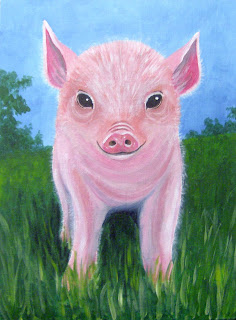 Well, the Eastern Idaho State Fair is over, but you can still find your HAPPY at the Blackfoot Art Center! How? By painting this smiley little pig!
Well, the Eastern Idaho State Fair is over, but you can still find your HAPPY at the Blackfoot Art Center! How? By painting this smiley little pig!I will lead this guided painting if there is enough interest. This would make a great Family Night or youth group project; each piggy could be different in his or her own way! Add a butterfly, flowers, curly eyelashes, or whatever suits your fancy!
This is a 12" x 16" canvas painting that is suitable for ages 8 up. Cost is only $15.00 per person (normally $25 for this size painting). Time: about two hours. Let me know on Facebook or on our website (use the Contact Us tab) if you are interested, how many seats, and the date(s) you would like to paint.
Mosaics!
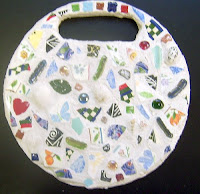
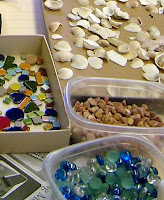 Here is one of our favorite projects! Great fun; beautiful projects to take home and show off!
Here is one of our favorite projects! Great fun; beautiful projects to take home and show off!Several of the kids made these as gifts and wrapped them up in studio before taking them out the door.
The mosaic at the top right is a "sampler," literally using one of each mosaic material.
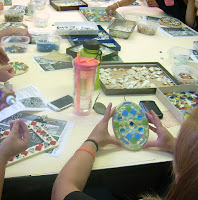
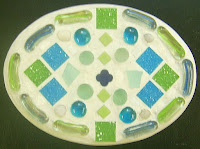
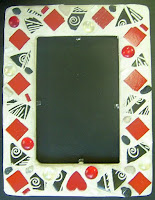
Others use some form of loose repetition in color, shape or design, and others are very symmetrical such as the red and black frame or the green oval design shown below.
We simply white-glued the broken dish pieces and other mosaic materials to a wood shape and allowed it to dry over night.
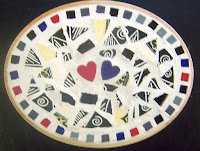
Then we used plaster of Paris as grouting material. Wipe it over the tiles, filling in all spaces thoroughly, wipe of the excess; then when dry, wipe again and polish with a soft cloth. Optional: Paint the side edges and back of the piece.
Native American Inspired Crafts
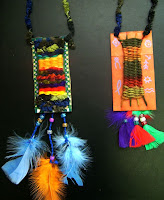
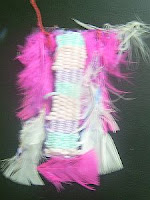 I wanted to be sure to include some of the Indian crafts we did last summer. The younger children made wearable weavings on cardboard looms, and the older kids made these plus miniature buffalo hides to which they added Indian symbols. We used fallen twigs, jute, and leather straps and scraps to assemble them.
I wanted to be sure to include some of the Indian crafts we did last summer. The younger children made wearable weavings on cardboard looms, and the older kids made these plus miniature buffalo hides to which they added Indian symbols. We used fallen twigs, jute, and leather straps and scraps to assemble them.Although tiny, these two projects had a rustic, authentic feel to them that the kids really enjoyed.
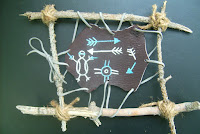
Folded Paper Collages
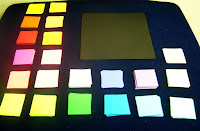
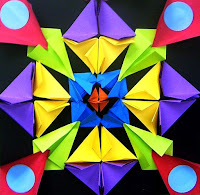 This awesome project was so popular last summer we did it again this summer - and the results were amazing! These are done with tiny sticky note-sized brightly colored copy paper, folded and glued into a symmetrical design to a black construction paper square. As you can see from these examples, we also incorporated punched out circles.
This awesome project was so popular last summer we did it again this summer - and the results were amazing! These are done with tiny sticky note-sized brightly colored copy paper, folded and glued into a symmetrical design to a black construction paper square. As you can see from these examples, we also incorporated punched out circles.The set up for this project is shown at the right. I showed the kids how to make basic folds (diagonals, hills, valleys, etc.) then encouraged them to make up their own folds. The idea is to choose a color and make four identical pieces from that color to place into a symmetrical design. Prior to gluing, the kids needed to fold the black paper diagonally in both directions, then unfold and fold again in half and in half again (quarters), and open. Flatten well and use these fold lines as guidelines for gluing down the folded "origami" papers symmetrically. Beautiful!
Thursday, July 16, 2015
Copper Tooling Doodling!
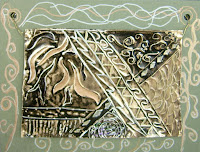 Everyone likes to doodle! During the first part of July, our youngest students, teens, and adults have all been doodling. What is doodling? Normally, it's one of those rare moments when the left brain gets bored and hands off a little bit of time to the right brain. In other words: the scholarly, logical, memorizing, linear, symbolic, mathematical, time-keeping, names-everything side of the brain gives the playful, intuitive, creative, free-thinking, analogical, nonverbal, visual side of the brain a small window in which to have some fun.
Everyone likes to doodle! During the first part of July, our youngest students, teens, and adults have all been doodling. What is doodling? Normally, it's one of those rare moments when the left brain gets bored and hands off a little bit of time to the right brain. In other words: the scholarly, logical, memorizing, linear, symbolic, mathematical, time-keeping, names-everything side of the brain gives the playful, intuitive, creative, free-thinking, analogical, nonverbal, visual side of the brain a small window in which to have some fun.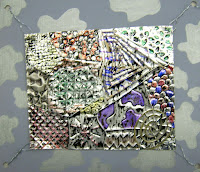
In art class, our goal is to allow the right brain to take over and keep the left brain quiet! Doodling is a great way to allow that to happen. Using the ideas in the Zentangle Method, we have found that doodling can be developed into structured patterns and beautiful pieces of art. Find out more about the Zentangle Method here.
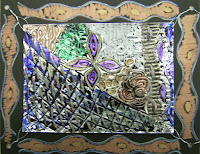 I like to introduce interesting materials, and kids love to try new things (especially unusual techniques and media), so we combined our expert doodling skills with copper tooling, to which we added India Ink and Sharpies for additional color and steel wool to rub the tooling. We mounted everything on mat board with gold or silver wire and decorated the framing with metallic pens. Beautiful results - and great fun!
I like to introduce interesting materials, and kids love to try new things (especially unusual techniques and media), so we combined our expert doodling skills with copper tooling, to which we added India Ink and Sharpies for additional color and steel wool to rub the tooling. We mounted everything on mat board with gold or silver wire and decorated the framing with metallic pens. Beautiful results - and great fun!
Sunday, June 21, 2015
New Drawing Class Just for Adults!
The Blackfoot Art Center has added an Adult Drawing & Sketching class to our schedule. This class will be held on Wednesdays from 10 am to 12 pm.
Can't draw a straight line? You don't need to -- no need for rulers in this class! All you need is a desire to learn to draw, practice your new skills, and have fun! If you are unable to attend this morning class, we also have a Tuesday evening open studio class for adults at 6:30 to 8:30 pm. As an option, you can attend this class and receive the same basic drawing instruction. Both classes are pay-as-you-go, only $10 per 2-hour class.
You are never too old to learn how to draw, so why not give it a try! No need to pre-register or bring anything special - we have everything you'll need to get started.
If you would like more information about the Blackfoot Art Center, please visit our new website at blackfootartcenter.org. It is currently a work in progress, so check back often for updated information!
Saturday, June 06, 2015
We've Moved!
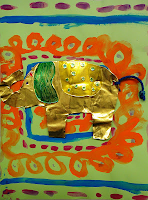 We've moved to a great new location in downtown Blackfoot! It wasn't easy; a lot of renovation was needed and it took longer than planned, but it was so worth it! We're now up and running in our bright, spacious new facility.
We've moved to a great new location in downtown Blackfoot! It wasn't easy; a lot of renovation was needed and it took longer than planned, but it was so worth it! We're now up and running in our bright, spacious new facility.Although our signage is not yet installed, you'll find us at 73 N. Broadway. Drop in during Open House through June 12th and take a look! Pick up a schedule of summer classes and let your kids hang out in the Creative Thinking Area and Open Art Studio while you fill out a quick survey. We want to know what we can offer you and your family. We have free refreshments and summer class registration forms. Sign up for a class or two. Would you like to teach an art class or a craft? Why not teach it at the at the art center? We are also looking for volunteers to help with children's classes and to promote the visual arts in other ways. Earn free studio time and/or discounts on classes.
This Thai elephant art, (from artiswhatiteach.blogspot.com) is just one of the projects we are doing in our new "Arty Animals" class, offered on Mondays from 3-4:30 pm (ages 6-11). This is Keyanna and her Thai Elephant. You can view and print a pdf of our full Summer 2015 Art Class Schedule as well as an Art Class Registration Form - just click on the links in the sidebar.
For more information about the Art Center, art classes/workshops, teaching your own classes, booking an arts/crafts birthday party, or to volunteer -- please call 208-252-7126.
Tuesday, March 24, 2015
Tiny Landscapes
Sounds like an oxymoron, right? Consider the fact that painting a landscape in a small format can remove many of the uncertainties and doubts beginners have about watercolor painting:
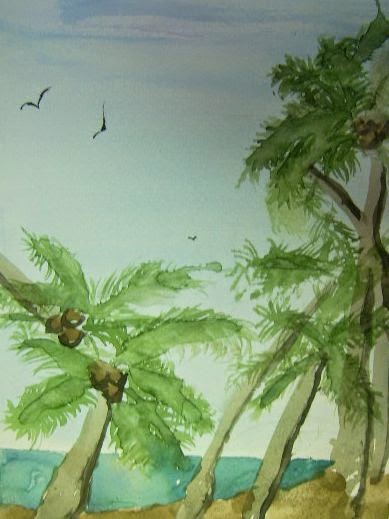 The process is simple. You'll need a 1/2 sheet of watercolor paper, approximately 5" x 8" and a basic watercolor pan set of 8 to 14 colors (nothing fancy). You'll need a soft round (not flat) watercolor brush - size 4 or 6, a mixing palette or tray, clean water, a drawing board, masking tape, and a No. 2 pencil.
The process is simple. You'll need a 1/2 sheet of watercolor paper, approximately 5" x 8" and a basic watercolor pan set of 8 to 14 colors (nothing fancy). You'll need a soft round (not flat) watercolor brush - size 4 or 6, a mixing palette or tray, clean water, a drawing board, masking tape, and a No. 2 pencil.
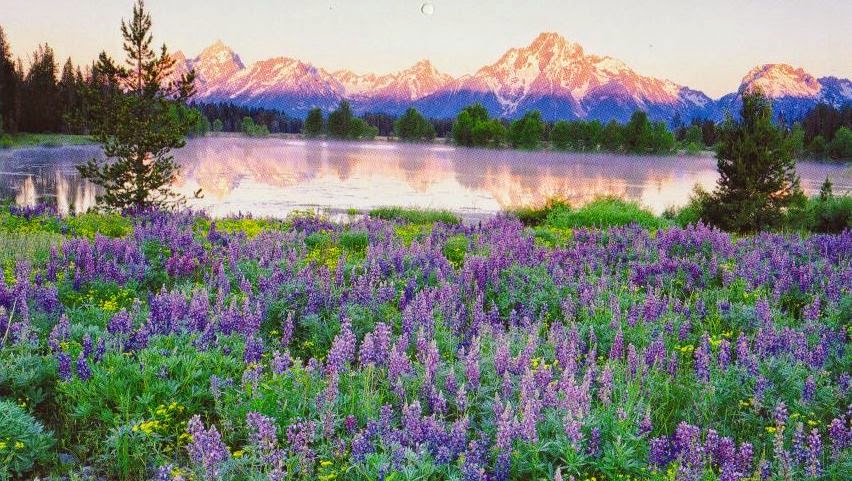 Mask the photo with strips of paper to reveal only the portion you plan to paint. Example: Use the top right quadrant of this landscape photo.
Mask the photo with strips of paper to reveal only the portion you plan to paint. Example: Use the top right quadrant of this landscape photo.
Simplify! You will not paint every detail - true art leaves something to the imagination.
Start with the distant background, usually with the sky, and work forward in space.
- No intimidating giant white space to fill up
- Forces selectivity in deciding what to include and what to leave out, making it --
- Easier to simplify the composition into basic shapes and forms within the limited space
- Encourages use of a limited palette in the planning stages of the painting
- Makes it easier to describe the essence or the impression of the scene instead of painting every detail
 The process is simple. You'll need a 1/2 sheet of watercolor paper, approximately 5" x 8" and a basic watercolor pan set of 8 to 14 colors (nothing fancy). You'll need a soft round (not flat) watercolor brush - size 4 or 6, a mixing palette or tray, clean water, a drawing board, masking tape, and a No. 2 pencil.
The process is simple. You'll need a 1/2 sheet of watercolor paper, approximately 5" x 8" and a basic watercolor pan set of 8 to 14 colors (nothing fancy). You'll need a soft round (not flat) watercolor brush - size 4 or 6, a mixing palette or tray, clean water, a drawing board, masking tape, and a No. 2 pencil.
Select a photo of a landscape that appeals to you. Our favorite resource for beautiful landscape photos (as well as animals and flowers) is old calendars - don't throw them away! For this project, look for a scene with a distant background, a mid-ground, and a foreground.
Study your landscape photo. With eyes half closed, look for shapes and forms. Look for a satisfying composition. Select only a section of a large landscape to paint - not the whole thing! Ask yourself - how can I describe an impression or the essence of this scene? Using your pencil, sketch in the basic forms and shapes. Use these tips to keep going:
Tape your watercolor paper to the drawing board. Tape all four sides, covering 1/8 to 1/4 inch of the paper all the way around to leave a nice white boarder when you peel off the tape.
 Mask the photo with strips of paper to reveal only the portion you plan to paint. Example: Use the top right quadrant of this landscape photo.
Mask the photo with strips of paper to reveal only the portion you plan to paint. Example: Use the top right quadrant of this landscape photo. Simplify! You will not paint every detail - true art leaves something to the imagination.
Start with the distant background, usually with the sky, and work forward in space.
Leave each area to dry before moving on to the next to avoid colors bleeding together.
Don't overwork it; know when to stop! Remember to keep it simple.
Raindrops and Puddles
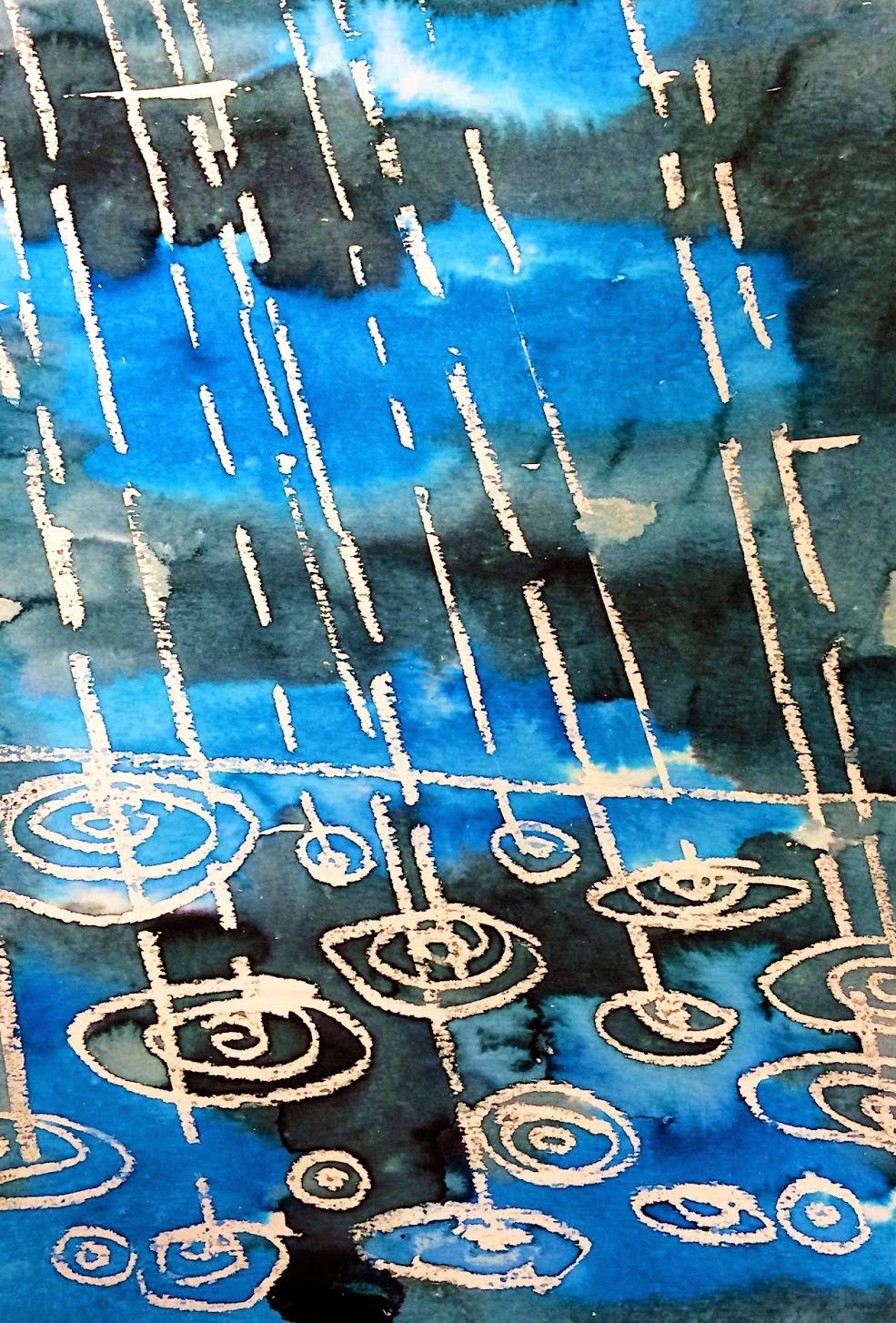 Watercolor is an ideal medium for "rain art." Makes sense, right? Continuing with watercolor week, our 2nd graders created a rainy day project using crayon resist and wet on wet watercolor. Unfortunately, I did not get many photos of their work in progress or completed projects - I may well have been too busy with the step-by-step process of this project. I borrowed these photos of student work, which are similar to our kids' results, from Elementary Art Fun. In fact, this art blog, also called smART Class, is a great place to go for new and innovative kids' art project ideas. I highly recommend it!
Watercolor is an ideal medium for "rain art." Makes sense, right? Continuing with watercolor week, our 2nd graders created a rainy day project using crayon resist and wet on wet watercolor. Unfortunately, I did not get many photos of their work in progress or completed projects - I may well have been too busy with the step-by-step process of this project. I borrowed these photos of student work, which are similar to our kids' results, from Elementary Art Fun. In fact, this art blog, also called smART Class, is a great place to go for new and innovative kids' art project ideas. I highly recommend it!If you are interested in trying this project, click on one of the links above for step-by-step instructions.
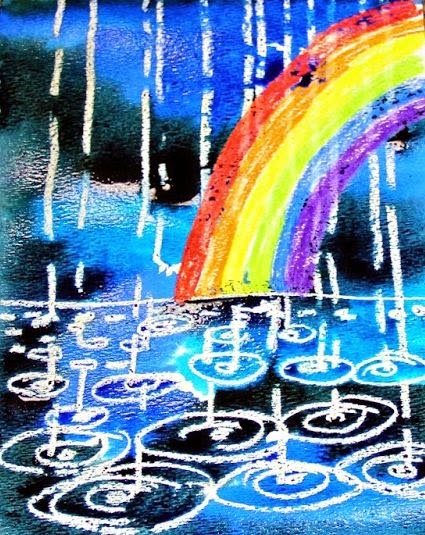
Supplies needed are heavy white art paper (copy paper curls too much), crayons (especially white), rulers, soft watercolor brushes, paint mixing trays, a rag, and watercolors - blue, black, turquoise. Liquid watercolors work best, but you can use pan watercolors successfully if you mix some nice puddles of color in your trays prior to painting.
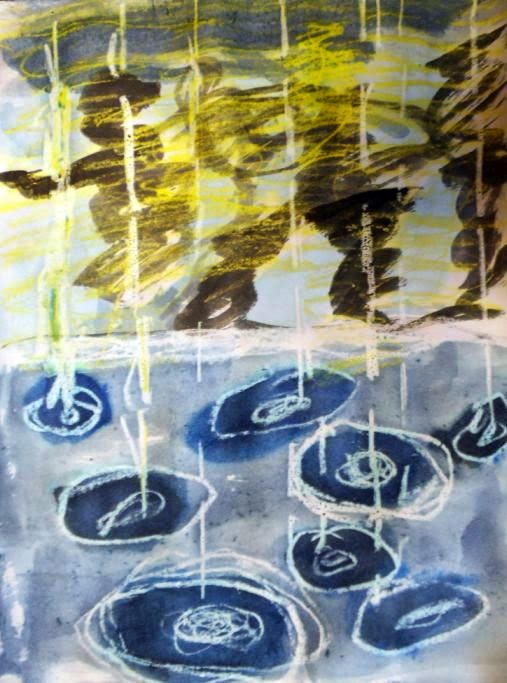
This painting, which was created by one of our students, has LIGHTENING!
It's so much fun introducing unexpected art elements and processes to young artists!
Renewed enthusiasm and self-discovery are just waiting to happen when you throw a little something different into the mix...
Friday, March 20, 2015
Wonderful Watercolor!
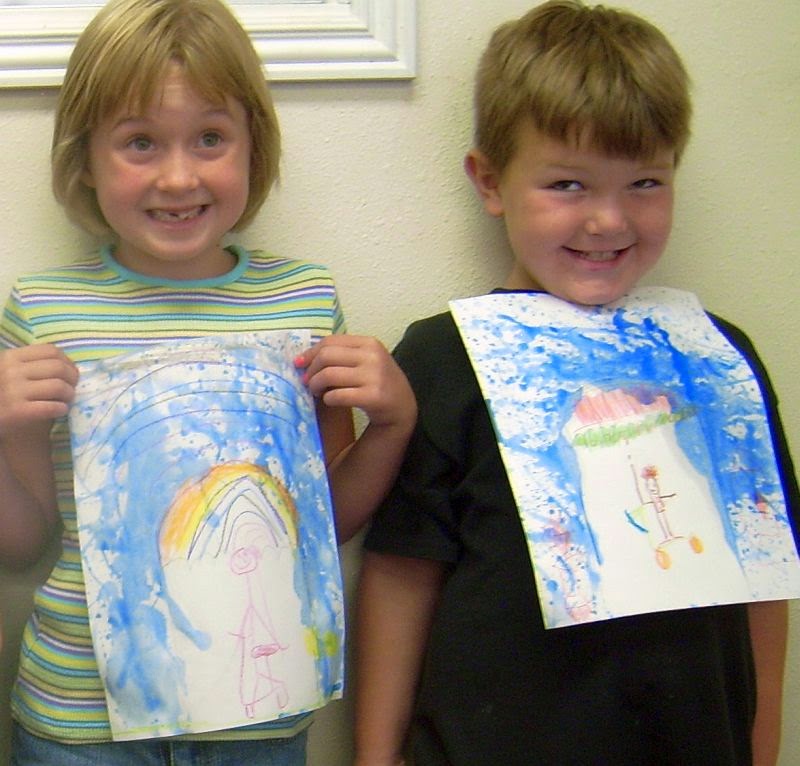 That little paint tin with 8 small pans of color and a brush - remember it? Add a cup of water and a sheet of paper, you're good to go. For art camp, however, I decided we needed a little something more.
That little paint tin with 8 small pans of color and a brush - remember it? Add a cup of water and a sheet of paper, you're good to go. For art camp, however, I decided we needed a little something more. 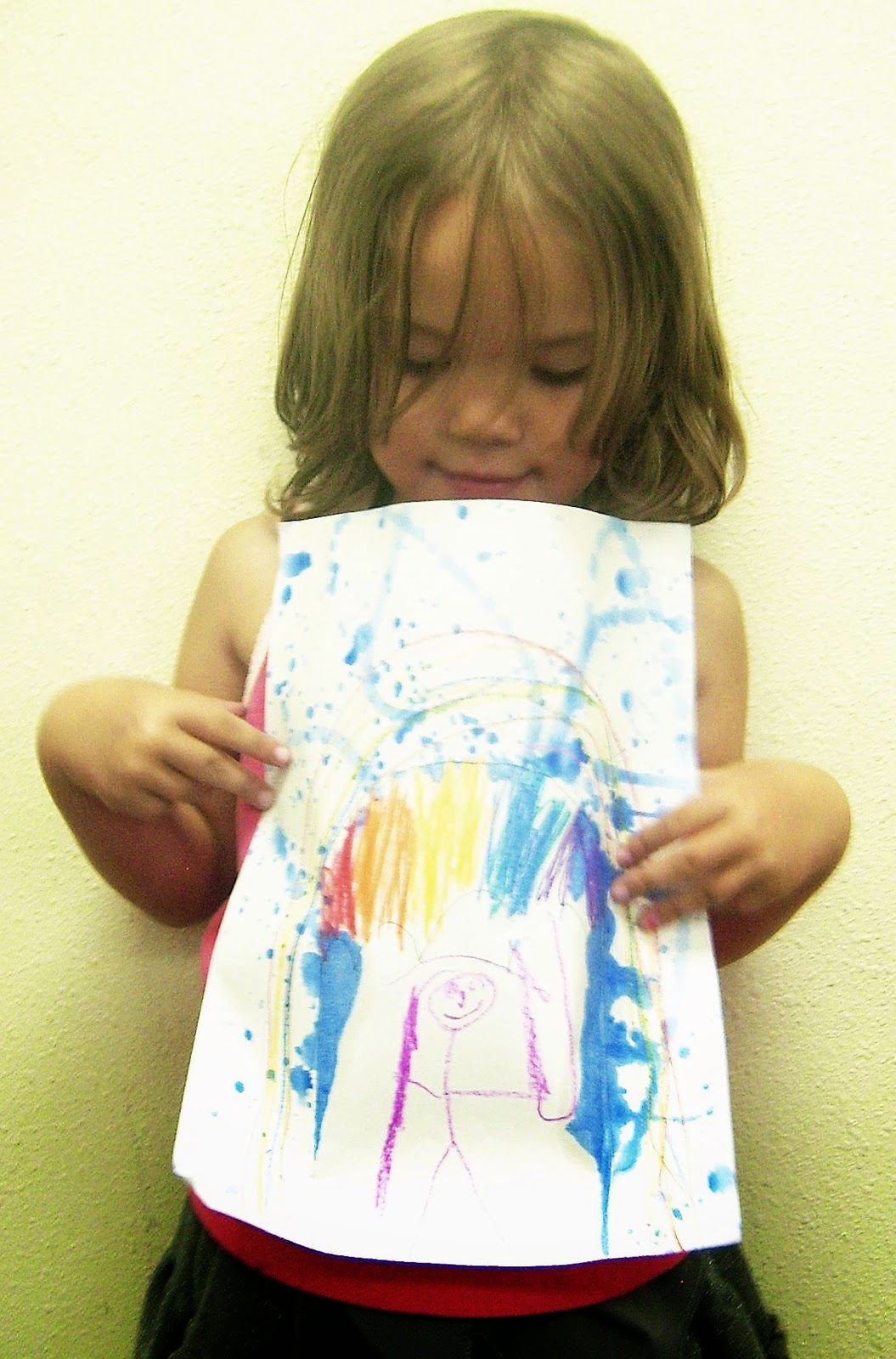 Our youngest artists imagined themselves walking through the rain under an umbrella - staying nice and dry. I cut a few thumb-shaped templates that they traced with a pencil to create the shape of an umbrella. Then they completed the umbrella and themselves under under it, and added lots of color. Once these were done, we placed the template back over the traced area to serve as a mask, and splattered the paper all over with a watery mix of blue watercolor paint. We lifted the template/mask and wa-la! Everything under the umbrella stayed dry! Tip - Show the children how to rub their thumb across the bristles of a large stiff paint brush to create some very nice splatters.
Our youngest artists imagined themselves walking through the rain under an umbrella - staying nice and dry. I cut a few thumb-shaped templates that they traced with a pencil to create the shape of an umbrella. Then they completed the umbrella and themselves under under it, and added lots of color. Once these were done, we placed the template back over the traced area to serve as a mask, and splattered the paper all over with a watery mix of blue watercolor paint. We lifted the template/mask and wa-la! Everything under the umbrella stayed dry! Tip - Show the children how to rub their thumb across the bristles of a large stiff paint brush to create some very nice splatters.Thursday, March 19, 2015
Manga Me!
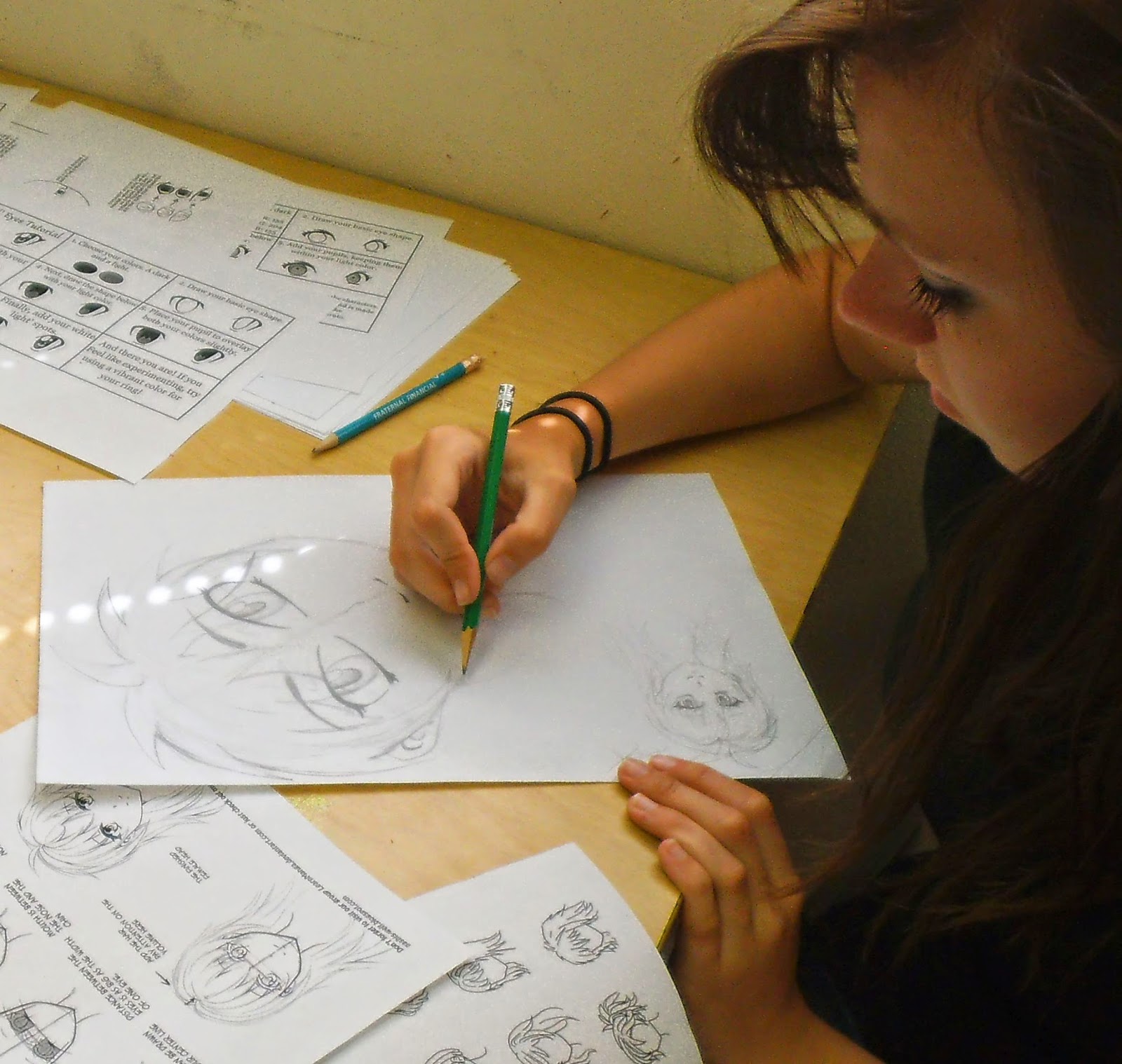 What do we know about middle school kids? They don't usually like to be the center of attention, or to focus on themselves, or to embarrass themselves - especially in front of their friends!
What do we know about middle school kids? They don't usually like to be the center of attention, or to focus on themselves, or to embarrass themselves - especially in front of their friends!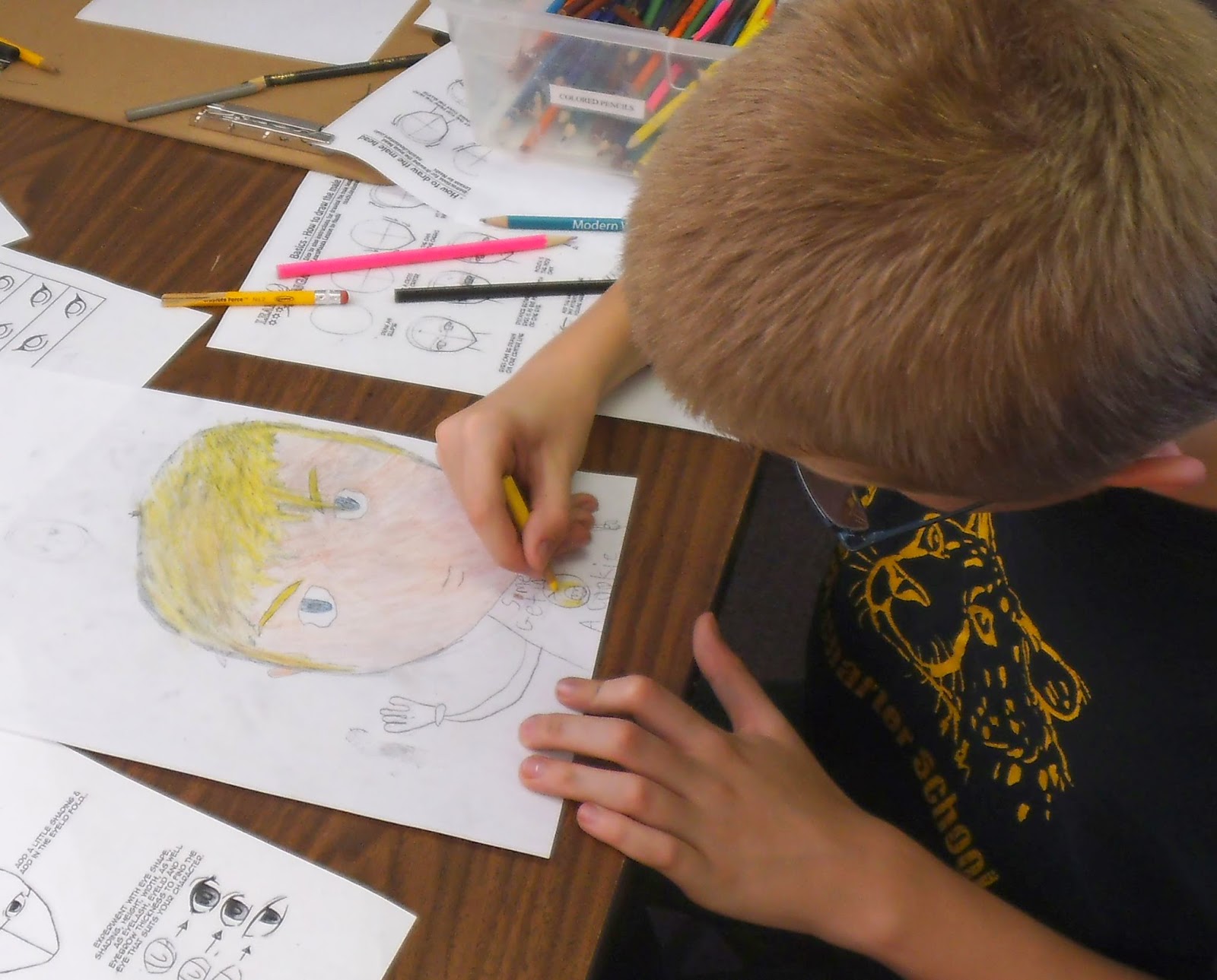
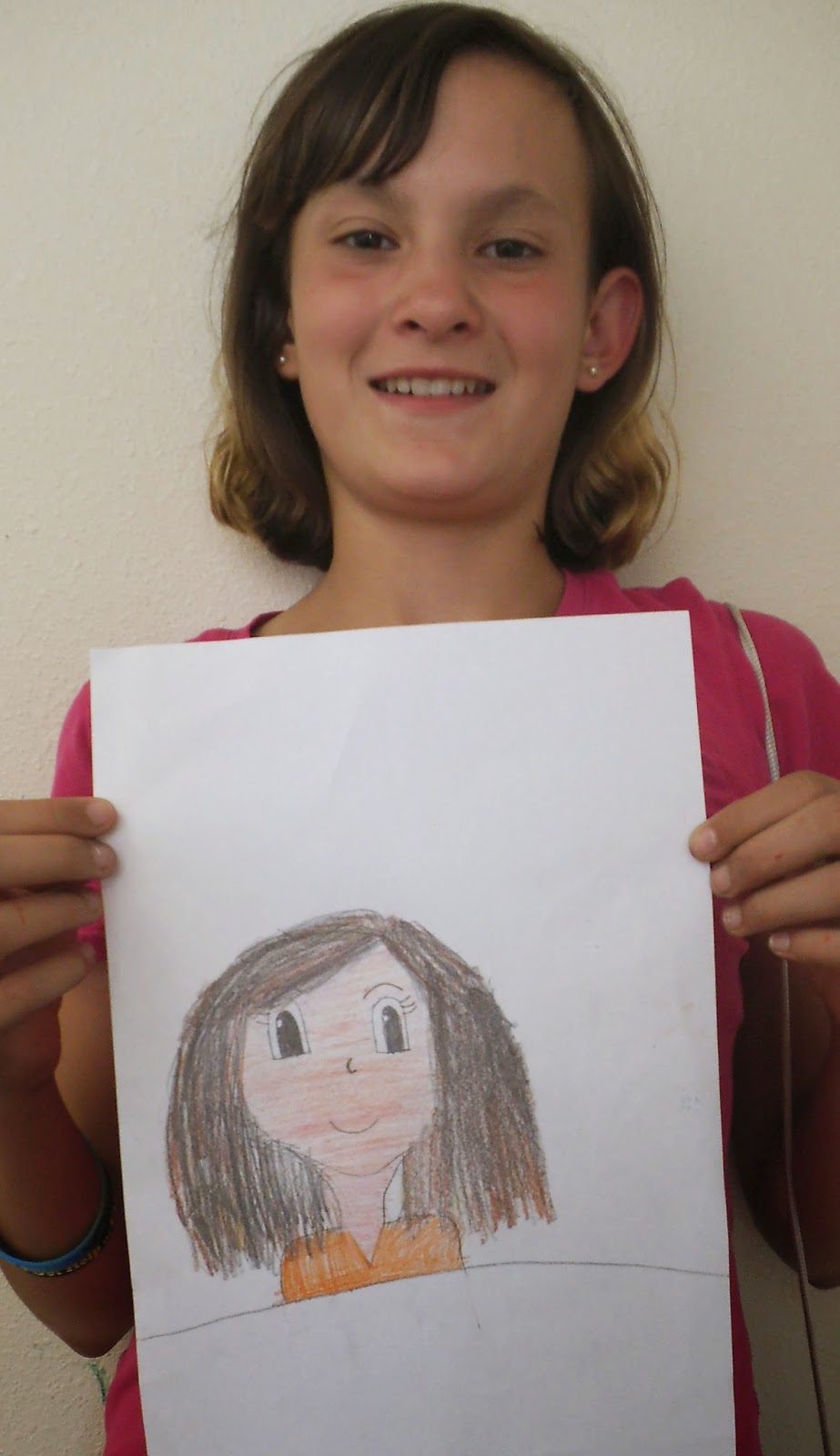 Knowing this, how could I expect them to draw self-portraits? What if it doesn't come out right? What if it looks silly or dumb? What if everyone hates it? OMG! Embarrassing!!!
Knowing this, how could I expect them to draw self-portraits? What if it doesn't come out right? What if it looks silly or dumb? What if everyone hates it? OMG! Embarrassing!!! I pictured in my mind wads of "artwork" filling the trash can. Definitely not a good art experience.
So I asked myself - what do these kids like? What would make creating self-portraits exciting and fun? After a quick bit of research, I found the answer - Manga art! Kids love Manga, and the idea of creating their own Manga avatars was a hit! I printed out a few instructional worksheets and made a set for each student. Note: We drew heads only at this point; however you can get instructions for whole body Manga art as well. I showed them some avatar samples, and then I let them go to work.
They loved it! Drawing themselves Manga style seemed to take away the seriousness of self-portrait drawing. It was more like a cartoon of themselves - and popular Mangas at that - with detailed instructions to follow for each facial feature. These could then be tweaked and colored to resembled their own individual features.
Manga self-portraits were really a hit, even with our youth leaders, shown above. Their avatars look just like them, don't you think?
So I asked myself - what do these kids like? What would make creating self-portraits exciting and fun? After a quick bit of research, I found the answer - Manga art! Kids love Manga, and the idea of creating their own Manga avatars was a hit! I printed out a few instructional worksheets and made a set for each student. Note: We drew heads only at this point; however you can get instructions for whole body Manga art as well. I showed them some avatar samples, and then I let them go to work.
They loved it! Drawing themselves Manga style seemed to take away the seriousness of self-portrait drawing. It was more like a cartoon of themselves - and popular Mangas at that - with detailed instructions to follow for each facial feature. These could then be tweaked and colored to resembled their own individual features.
Manga self-portraits were really a hit, even with our youth leaders, shown above. Their avatars look just like them, don't you think?
Wednesday, March 18, 2015
I'm Falling ! ! !
Our 5th graders tried self-portraits with a twist. They drew themselves falling through space and learned about foreshortening in the process.
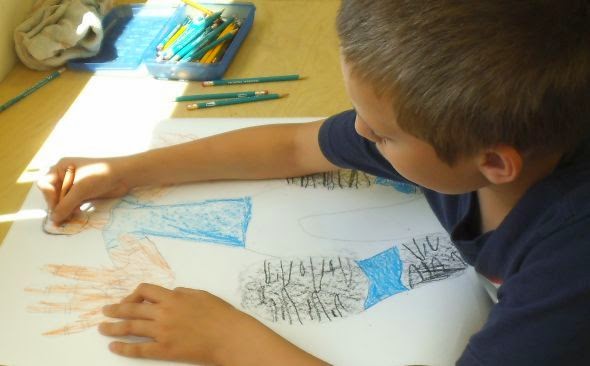 Foreshortening is an optical illusion that is created when you draw the part of an object that is closest to you larger than the portion that is farther away. This is actually just a form of perspective, but sometimes it is difficult for beginners (including adults) to see and draw.
Foreshortening is an optical illusion that is created when you draw the part of an object that is closest to you larger than the portion that is farther away. This is actually just a form of perspective, but sometimes it is difficult for beginners (including adults) to see and draw.
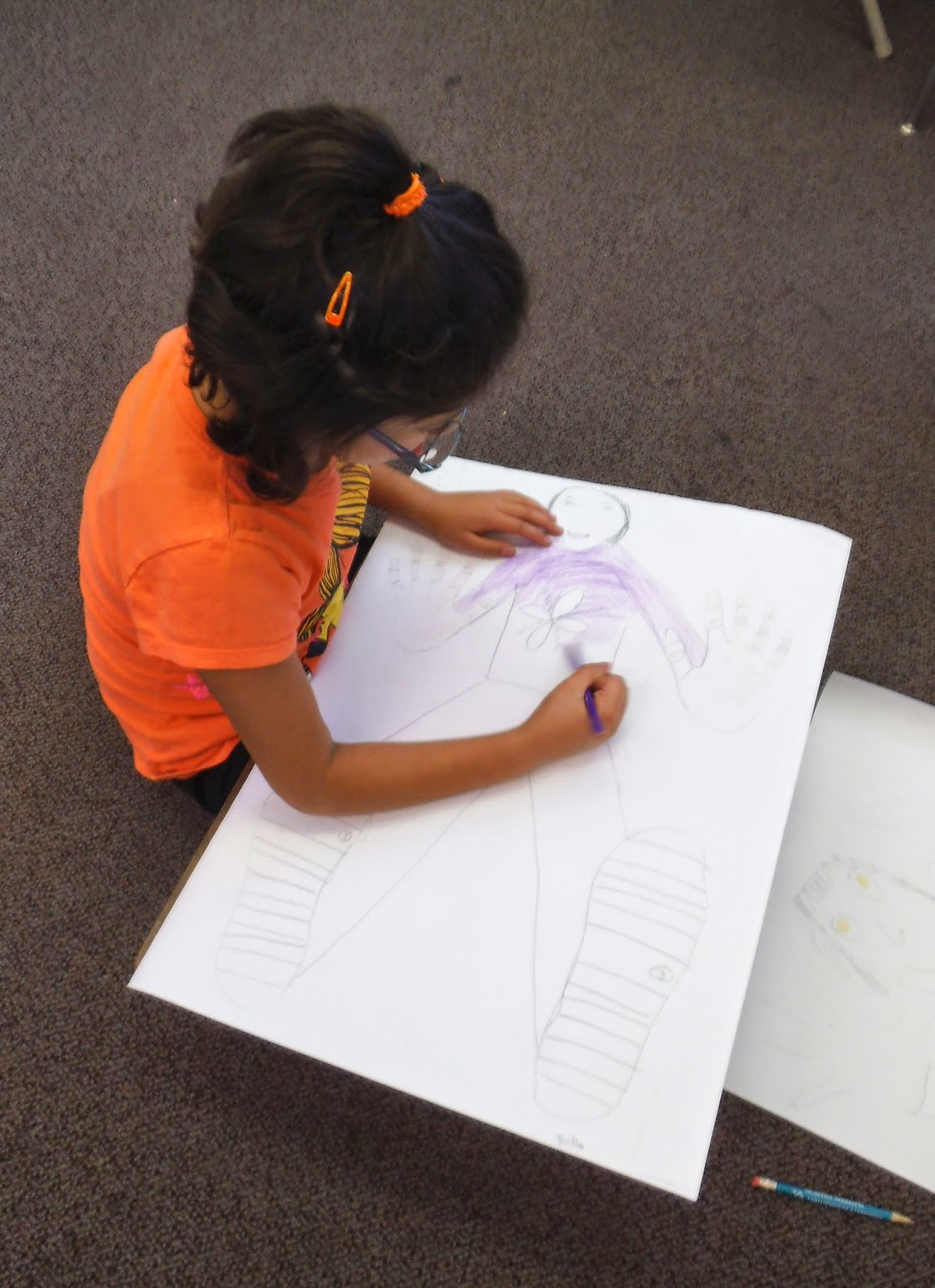 To do this project you need a large sheet of paper, at least 18" by 24." This is because the artists will be life size! Well, at least their hands and feet. Each artist will need the help of another artist to start this project. Begin by standing on the paper (placed on a hard surface), somewhere near the bottom edge and having your partner trace your feet. Now the hands, with fingers outstretched, will need to be traced. The hands should be placed somewhere near the outer edges and above the feet.
To do this project you need a large sheet of paper, at least 18" by 24." This is because the artists will be life size! Well, at least their hands and feet. Each artist will need the help of another artist to start this project. Begin by standing on the paper (placed on a hard surface), somewhere near the bottom edge and having your partner trace your feet. Now the hands, with fingers outstretched, will need to be traced. The hands should be placed somewhere near the outer edges and above the feet.
After everyone's hands and feet are traced, the artist now draws in the arms, legs, body, and head to create the illusion the the body is further back in space that the feet and hands. The image will appear to be falling towards the viewer!
Once the basic drawing is done, it is time to fill in the details, including the pattern on the bottoms of shoes and the wrinkles in the fingers. Color in the clothing and other details, while making any adjustments to the body proportions to make the illusion work.
 Foreshortening is an optical illusion that is created when you draw the part of an object that is closest to you larger than the portion that is farther away. This is actually just a form of perspective, but sometimes it is difficult for beginners (including adults) to see and draw.
Foreshortening is an optical illusion that is created when you draw the part of an object that is closest to you larger than the portion that is farther away. This is actually just a form of perspective, but sometimes it is difficult for beginners (including adults) to see and draw.  To do this project you need a large sheet of paper, at least 18" by 24." This is because the artists will be life size! Well, at least their hands and feet. Each artist will need the help of another artist to start this project. Begin by standing on the paper (placed on a hard surface), somewhere near the bottom edge and having your partner trace your feet. Now the hands, with fingers outstretched, will need to be traced. The hands should be placed somewhere near the outer edges and above the feet.
To do this project you need a large sheet of paper, at least 18" by 24." This is because the artists will be life size! Well, at least their hands and feet. Each artist will need the help of another artist to start this project. Begin by standing on the paper (placed on a hard surface), somewhere near the bottom edge and having your partner trace your feet. Now the hands, with fingers outstretched, will need to be traced. The hands should be placed somewhere near the outer edges and above the feet.After everyone's hands and feet are traced, the artist now draws in the arms, legs, body, and head to create the illusion the the body is further back in space that the feet and hands. The image will appear to be falling towards the viewer!
Once the basic drawing is done, it is time to fill in the details, including the pattern on the bottoms of shoes and the wrinkles in the fingers. Color in the clothing and other details, while making any adjustments to the body proportions to make the illusion work.
Subscribe to:
Comments (Atom)
















